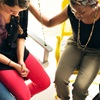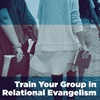The Small Group Movement: recent history
It is no secret that there are multiple movements taking place across the kingdom landscape. Only time will tell which ones survive and thrive. One thing is for certain, however, communal life is central to almost all of the current emerging expressions of church life. More intentional than the previous generation, the rising cadre of church leaders consists largely of communal architects, shaping the church into smaller communities for greater missional impact and presence. Not since Wesley's little bands of the 1700's, the haystack prayer gatherings of 1806 and beyond (starting from a small group of 5 and launching prayer groups still today), and the Jesus Movement of the 1960's have we seen such a church-wide emphasis on community.
The small group movement that burst onto the scene in para-church groups in the 1950's-70's began to find a home in the church in the 80's-90's. Meta-church models, cell churches, mini-churches, discipleship groups, recovery ministries, and evangelistic groups emerged. As a result, churches began to embrace group life as important for growth, but still treated this form of community as a program: "We do groups." The last 10 years has seen a move beyond that narrower focus, where groups are still essential to spiritual growth but are connected to larger mid-sized communal gatherings.
Communal life—in all shapes and sizes
House churches, neo-monastic communities, ministry teams, small groups, neighborhood gatherings, and missional communities are all examples of the Church becoming increasingly communal as it becomes increasingly mission-focused. This emphasis among emerging church adherents is refreshing, many of whom are 18-35, though not limited to that age. Less interested in building churches, emerging church leaders strive first to become the church, seeking a dynamic and fluid communal life centered in the places where people work and live. Being the church is essential—that means serving neighbors, a presence in the community, and a desire to live in proximity to those not affiliated with a church.
Group life in this emerging environment is more organic and less programmatic. Nonetheless, small groups of people, gathered for prayer, study, service, "hanging out" at the coffee shop, are central to the way of life espoused by these various communities. Here are a few distinctions of these groupings from the "small groups as a program" approach that was more common in the previous decade.
From strategic model to organic structure
Emerging church leaders see group life as organic but recognize the need for some structure. The structure, however, is not a set model or system that all must follow, but rather a driving set of values and experiences. Small groups emerge from larger communal gatherings—some intentional, some long-term, and others short-term and highly fluid. The mid-sized community is the place of connection and relationship forming. Smaller groups form for specific growth and service purposes. As we have always said, "The structure serves the people; the people do not serve the structure."
From content to process
A renewed emphasis on process—intentionally engaging with truth relationally and holistically—will shape the way groups do Bible study and spiritual formation in the emerging generation. This shift from Bible study to Bible practice reflects Jesus' teaching in Matt. 7:24-27. Groups are interested in how we are becoming a community instead of being content with what the community is doing (bible study, prayer, etc.). The relational environment and process of a group—at dinner, serving the poor, reading Scripture—is just as vital as the topic or focus of the group.
From building a program to creating an environment
A "group program" that is carelessly added on to a church driven by events will fail. Communal environments must be created church-wide —small, mid-sized, and larger. In these gatherings, spiritual journeys can be understood as people connect and next steps toward growth and relationship can be discerned. Small groups are formed to meet needs, to learn biblical truth, and to pursue growth.
From on-site training to decentralized development
Challenging schedules keep leaders from attending training events. Taking leadership development to leaders—in homes, coffee shops—is an emerging, growing trend. Rather than training a leader and then looking for a group for them to lead, communities are formed and leaders begin to emerge.
Church movements
As I speak with emerging leaders and communal architects, it is clear that smaller groups and expressions of community are essential to their mission. Just this week I met with a number of leaders. Some are moving into apartments, starting a small core community of 5-7, and beginning to connect with others. The goal is to become the church in that space, and then to replicate that. One leader envisioned an area of apartments and rental properties filled with such groups, describing it as "missional acupuncture." He targets these areas because here in Chicagoland, over 40% of people live in such areas and less than 5% of churches have any ministry there. These are dense, small areas, ideal for starting missional groups and communities that embrace the value of small groups but have a more organic fluidity because of relational proximity and density.
In suburban culture, there is a great desire to connect and recover a communal life lost during the fragmentation of the modern era. As a result, neighborhood gatherings are beginning to become the hub of community life, spawning small groups, short-term learning communities, serving teams, and a variety of ad hoc gatherings. While some house churches are larger (40-60) many new house church movements have 9-12 people per church, and intentionally reproduce if the group gets much larger. Reaching people where they live requires a model that is flexible and easily reproducible, void of the constraints of traveling to a church building across town.
The Future of Small Groups
Small groups are not going away. Actually, they are more essential than ever in light of the move away from large classes and programs and toward young churches meeting in homes and rented facilities. Groups of 6-10 people meeting 2-4 times a month for prayer, study, fellowship and support are still effective and valid expressions of community. Many of us have grown by leaps and bounds in such settings. They may offer what other gatherings generally cannot. A monthly neighborhood gathering is great for connection, basic sharing of resources and ideas, and serving the needs of the community. Intentional spiritual development, however, is lacking without regular connection with fewer members in an environment where deep change can be provoked and evaluated. While spontaneous connections and impromptu gatherings are essential to communal life, they do not replace the need for focused groups where spiritual guides (shepherds, leaders) can prompt growth and facilitate achievement of the group's purpose.
Small groups provide a place for intentional personal reflection, learning spiritual practices, gaining wisdom and feedback about habits, decisions and character traits, and for building trust with a few who really know you and your story. This contribution to the kingdom remains a core expression in thriving modern and post-modern churches alike. Though the terminology and structure will vary across movements, the support and nurture provided by small group life is a common thread.
I am excited to see the role of small groups increasing as the value of communal life pervades the church. As the rising generation of leaders creates new expressions of church, new forms of group life will emerge. I am also excited to be among those who are in the midst of the change. Remember, wherever two or three are gathered…









